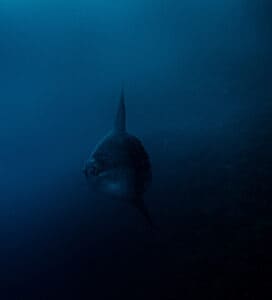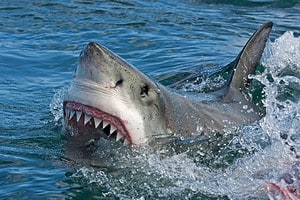Common fish that start with the letter S include sole, sea bass, sharks, shad, speckled trout, skipjack tuna, sea lamprey, sawfish, stonefish, sturgeon, snapper, swordfish, salmon, siamese fighting fish, and seahorse. Read on to learn more about these amazing fish!
Thirty-two thousand fish species exist in our planet’s oceans, seas, rivers, lakes, estuaries, lochs, ponds, and aquariums, and that’s more than we can list! However, if you’re interested in S letter fish, here are 81+ fish that start with S. We’ve included saltwater, freshwater, and tropical species to mix it up.
Let’s take a closer look at 14 fish that start with S before listing 81+ fish in the table below.
Sole (Solea Solea)
In Europe, sole fish are members of the Soleidae family, but elsewhere, the term “sole” often includes any type of flat fish.
The Dover sole, or common sole, is a flatfish that lives beneath seabed sand and mud in the Mediterranean and North Atlantic seas. Sole flap their sides to cover themselves in the substrate to hide from predators and surprise their worm, crustacean, and mollusk prey.
Their upper sides are grey and brown, but their undersides are bright white. On average, a sole reaches 28 inches long. They are popular for eating fish caught with trawler nets on the seabed.
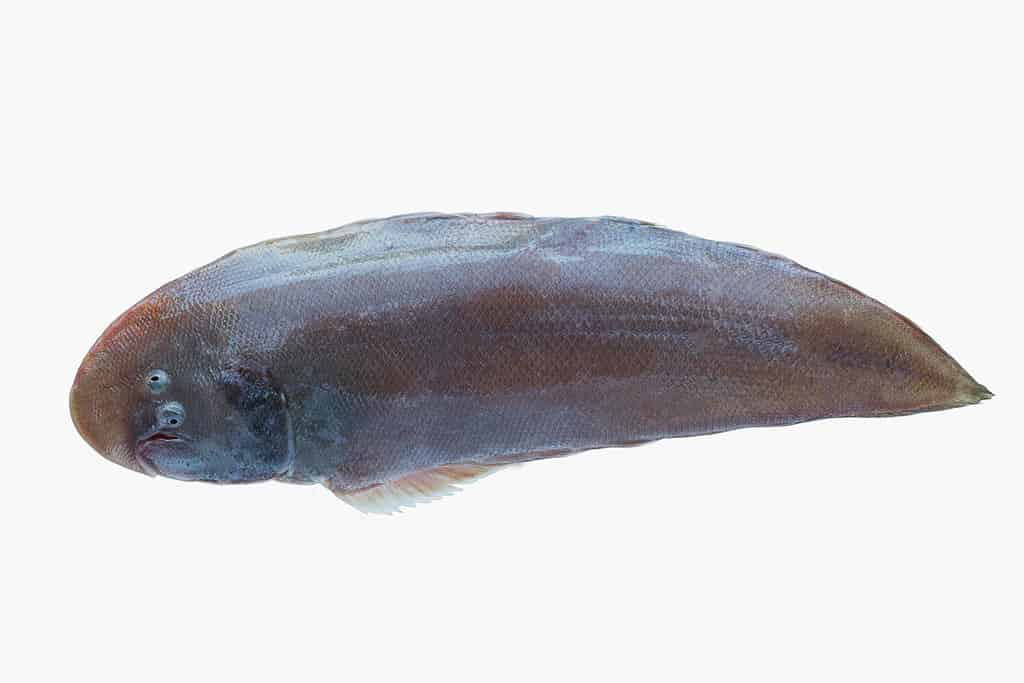
True soles have a salmon and gray coloration on the upper side of their body, while the underside is white or yellowish in hue.
©COZ/Shutterstock.com
Sea Bass (Dicentrarchus labrax)
Other common names of the sea bass include European bass, white bass, capemouth, and sea perch. It’s an ocean-borne fish of many species. There are 475 species in the sea bass Serranidae family, and they live mostly in shallower areas.
Sea bass have elongated bodies, small scales, and large mouths with protruding lower jaws. Long dorsal fins give this fish away, along with stout, strong, full bodies. Sea bass comes in a vast range of sizes, from 1.5-inch species to nearly nine feet long. Some of the larger sea bass weigh 880 pounds.
Sharks (Selachimorpha)
Sharks are elasmobranch fish with five to seven gills and strong, powerful bodies. Carnivorous sharks (except the vegetarian bonnethead shark) hunt fish, mammals, birds, and crustacean prey and range from 6.7 inches to over 40 feet in length. Dermal denticles preventing skin damage cover the sharks’ bodies. Many also have replaceable teeth.
The most famous sharks are the large great whites, tigers, and bull sharks that occasionally attack humans, but many species are under threat from overfishing for foods such as shark fin soup.
Shad (Alosa sapidissima)
Shad is a fish family with 30 species. One of the most popular is the American Shad, which was introduced from the Atlantic Ocean to the Pacific Ocean in 1871 as a game fish. They are migratory plankton eaters and very tasty.
Shad are pelagic schooling fish that live in large groups for safety. They have a notch in their upper jaw that the lower jaw neatly fits inside. Adult shad have no teeth, deep, strong bodies, and reach 30 inches in length.
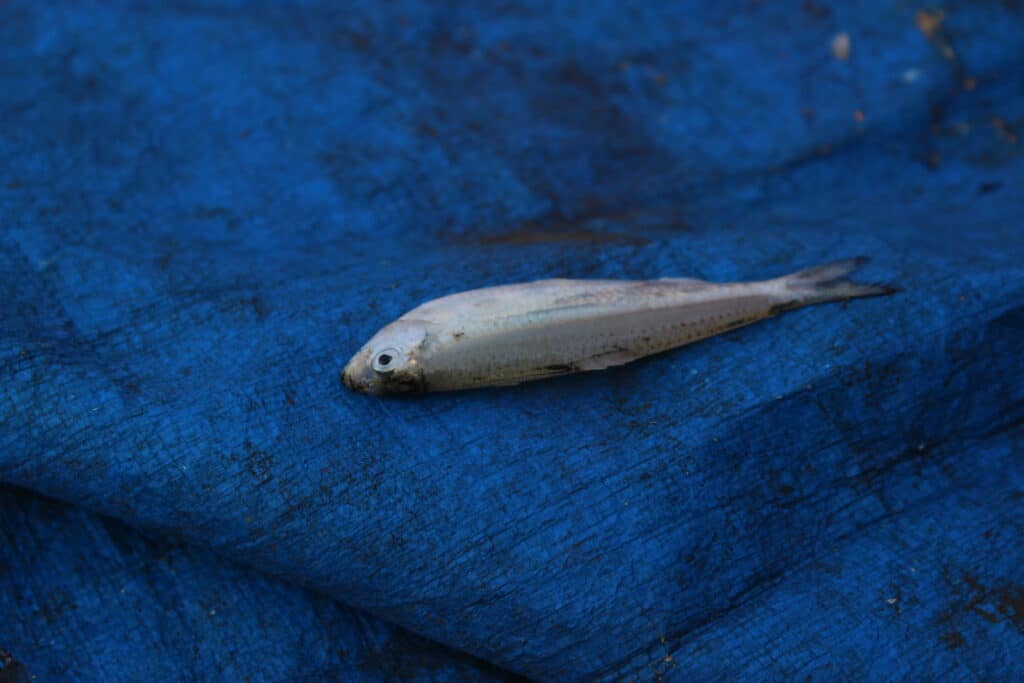
They are migratory plankton eaters and very tasty.
©Radhe Modi/Shutterstock.com
Speckled Trout (Salvelinus fontinalis)
Speckled trout are freshwater fish in the Salmonidae family. Native to North America and Canada, they have been introduced to Europe and Asia’s clean, cool streams. Speckled trout are important in the Chesapeake Bay Program.
These distinctive fish have dark green sides speckled with yellow and red spots and orange-red fins. They are wide in the center, taper at the head and tail, and reach up to 12 inches long. Speckled trout eat aquatic animals such as water nymphs, beetles, and worms.
Skipjack Tuna (Katsuwonus pelamis)
Skipjack tuna are three-foot-long pelagic fish that live in warm seas. They are fast fish, streamlined with dark purple and blue backs and silver bellies with four to six dark bands. Skipjack tuna shoal in groups of 50,000, and they are an important part of the food chain, providing food for sharks, dolphins, and other large pelagic fish.
Skipjack tuna are top predators in the food chain, preying on crustaceans, mollusks, and cephalopods. They are the smallest and most abundant commercial tuna fish and often the species that end up in our tuna fish cans.
Sea Lamprey (Petromyzon marinus)
Sea lampreys are eel-like fish without fins but with a jawless mouth that clamps onto other fish and sucks their blood. This habit gives rise to the alternative name “vampire fish.” This parasitic fish is native to the Atlantic Ocean and has olive or brown and yellow skin with black bands. They’re able to reach 47 inches long and weigh over five pounds.
Sea lampreys create problems when they migrate from the sea up rivers to spawn. There, they damage fishery stocks so much that the Great Lakes Fishery Program controls their numbers using lampricides on their river-borne larvae.
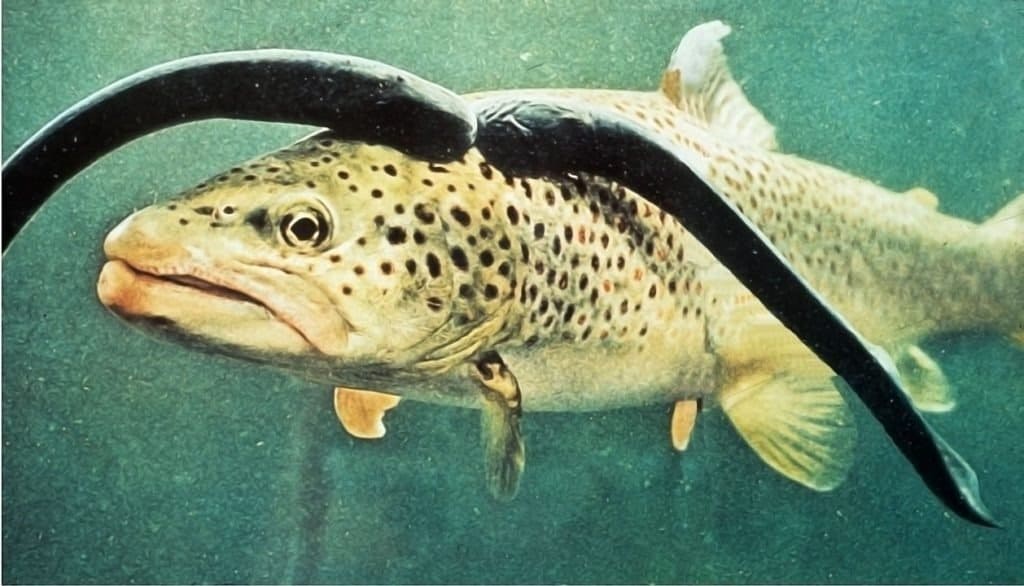
This parasitic fish is native to the Atlantic Ocean and has olive or brown and yellow skin with black bands.
©Sweeting, Roger [Photographer] (2016) Sea lamprey parasitising brown trout. Freshwater Biological Association, UK / Creative Commons – License
Sawfish (Pristidae)
Sawfish, known as carpenter sharks, have distinctive faces you just can’t miss. Their long, narrow rostrum (nose) resembles a long saw with transverse teeth on either side. Their pretty weird mouth and nostrils sit on the head’s underside so they can vacuum up creatures from the sea floor.
Sawfish reach 25 feet long, and they live worldwide in tropical and subtropical areas. They also enter coastal marine and estuarine waters, swimming up freshwater rivers and lakes.
Sawfish are critically endangered. It’s illegal to hunt them almost worldwide.
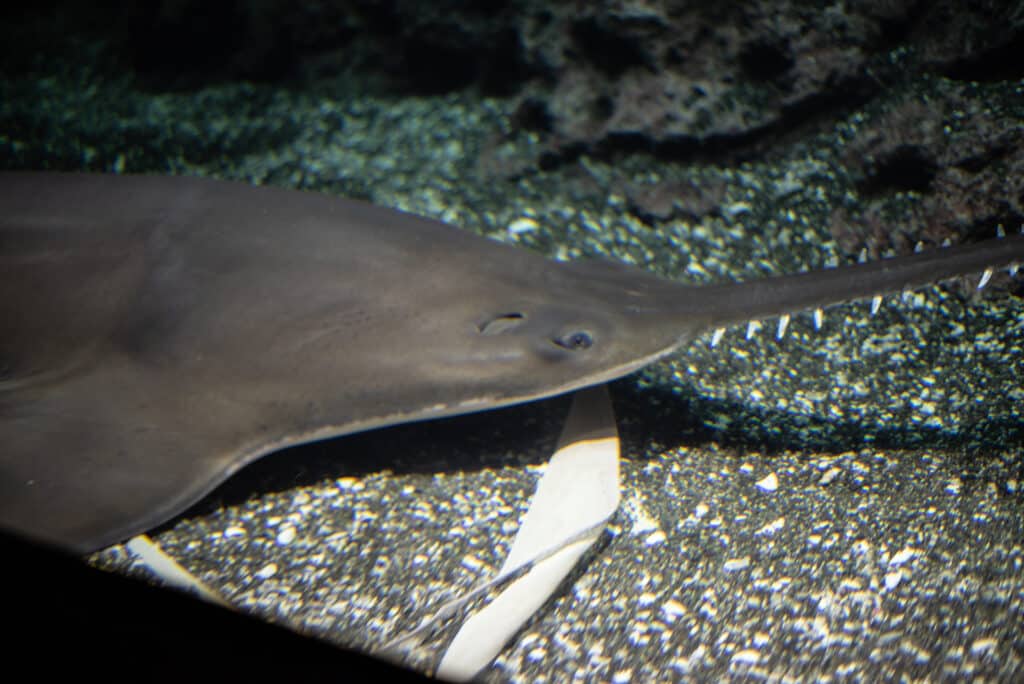
Sawfish’s long, narrow rostrum (nose) resembles a long saw with transverse teeth on either side.
©iStock.com/rmbarricarte
Stonefish (Synanceia verrucosa)
Stonefish are poisonous marine fish in the Synanceia genus. They thrive in the tropical Indo-pacific shallow waters, living on the sea floor where they eat crustaceans.
These fish measure up to 13 inches long. They are slow-moving and spend most of their time in coral reefs or mudflats, where their bumpy, warty skin camouflages them against sharks, rays, and sea snakes.
They are highly toxic and inject large amounts of venom through their spines if trodden on. A stonefish stab is very painful and requires medical assistance.
Sturgeon (Acipenseridae)
Sturgeon refers to 28 species of fish native to Eurasia and North America’s temperate, sub-Arctic, and tropical rivers, coastlines, and seas.
These large 7-12 feet long fish have smooth-skinned, scale-less bodies. Spindly and armored with bony scutes, they have long, mottled bodies and chin whiskers. Several sturgeon species are critically endangered due to overfishing for their roe.
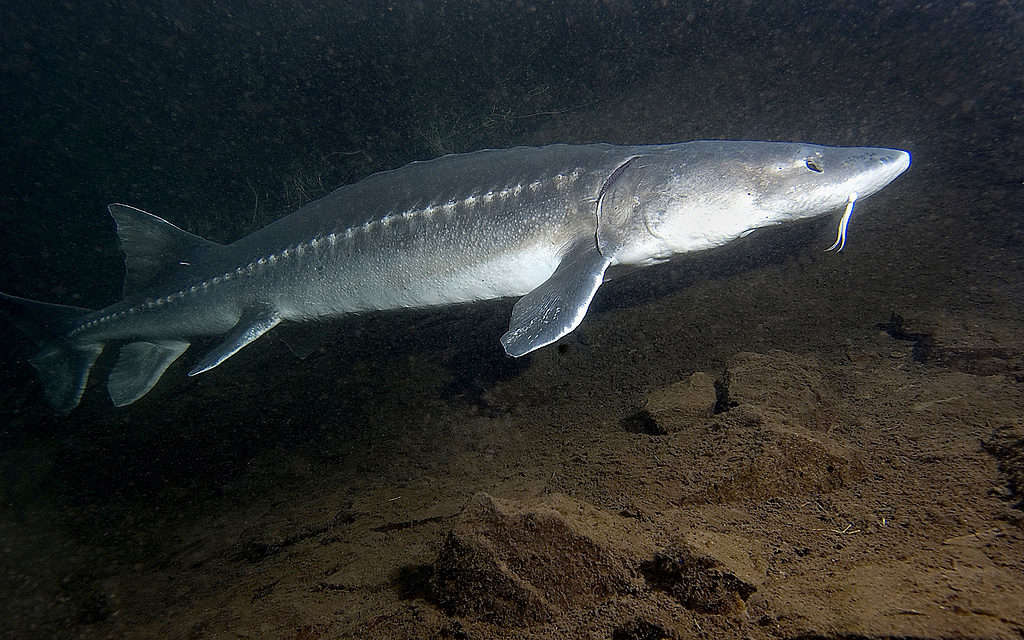
Spindly and armored with bony scutes, they have long, mottled bodies and chin whiskers.
©Oregon Department of Fish & Wildlife, CC BY-SA 2.0 <https://creativecommons.org/licenses/by-sa/2.0>, via Wikimedia Commons – License
Snappers (Lutjanus)
Snapper fish live in the tropics. There are 105 species of snapper, but generally, they all reach 2-3 feet long and hunt other fish, plus crustaceans and mollusks.
Snappers are so-called for their huge jaws, strong dog-like teeth, and forked tails. They are quite frightening fish to look at, but their array of colors, including red, vermillion, blue, yellow, and striped, is striking.
Swordfish (Xiphias gladius)
Fifteen-foot-long swordfish are the only members of the Xiphiidae family. They’re found in warm or temperate water worldwide.
Swordfish get their name from their long-head sword that’s used to fend off predators such as sharks. The sword is flat, unlike a marlin whose sword is rounded. These incredible fish don’t have scales but rough skin and a towering dorsal fin. It’s easy to identify a swordfish because, as well as the impressive face sword they have no pelvic fins.
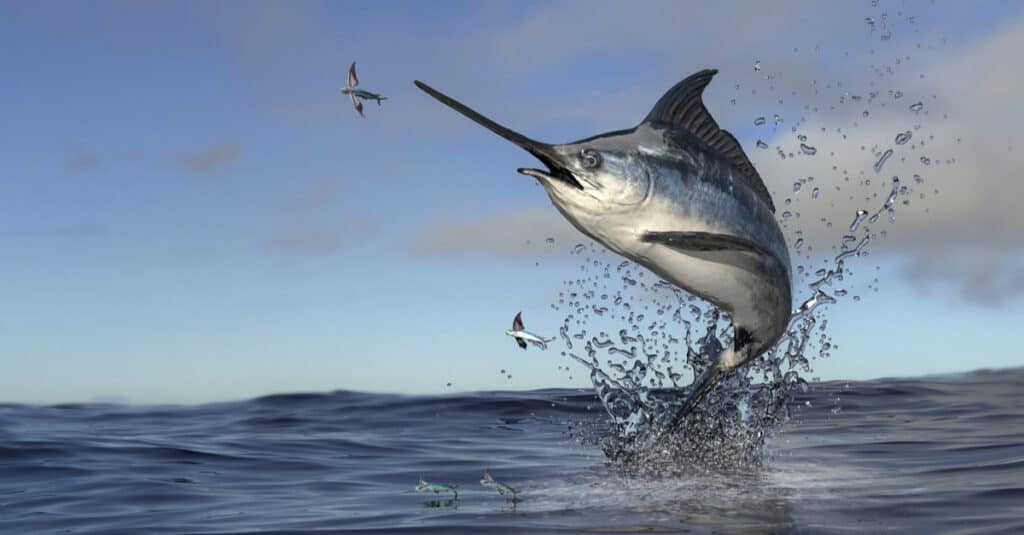
Swordfish are large, highly migratory predatory fish characterized by a long, flat, pointed bill.
©bekirevren/Shutterstock.com
Salmon (Salmo salar)
We all know salmon from the dinner plate, so we couldn’t leave it off a list of fish that start with S. It’s a pink fish packed with oils and healthy fats. Humans enjoy eating salmon, as do cats, dogs, and Alaskan bears that catch salmon jumping upstream.
This fish family is native to the North Atlantic’s tributaries and the North Pacific basin. Salmon are pink with grey backs and fin spots. Long and slender, powerful fish, the females are usually larger. Salmon are popular sport fish.
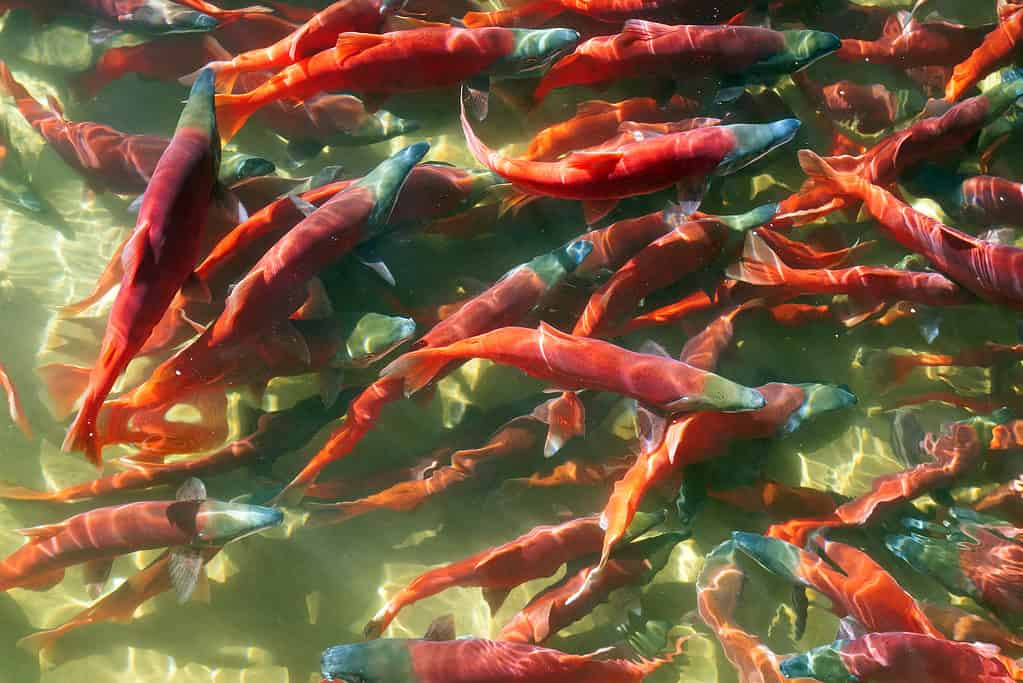
Humans enjoy eating salmon, as do domestic cats, dogs, and Alaskan bears that catch salmon jumping upstream.
©IrinaK/Shutterstock.com
Siamese Fighting Fish (Betta splendans)
Siamese fighting fish are aquarium favorites and are better known as bettas. Their name comes when males fight for females, so only one male per tank is advised.
Native to Asia’s shallow marshes, ponds, and streams, the male fish are attentive fathers that build nests for young betta fish and guard them against predators.
Bettas reach three inches long and only live for a few years, but their flowing fins make them attractive aquarium pets.
Seahorse (Hippocampus)
Let’s finish up with beautiful seahorses. Loved worldwide, this group of 43 species is known for its long, horse-like snouts, fat tummies, and monkey-like curved tails.
Their curved tails hold seagrass to prevent sea currents from blowing them away from coral and seagrass habitats in warm or temperate seas.
Seahorses range from 1.5 to 14 inches long, and scaly plates cover their curvy bodies. A female seahorse places her eggs into a pouch on the male seahorse’s stomach, where the babies develop for nine to 45 days before entering the ocean.
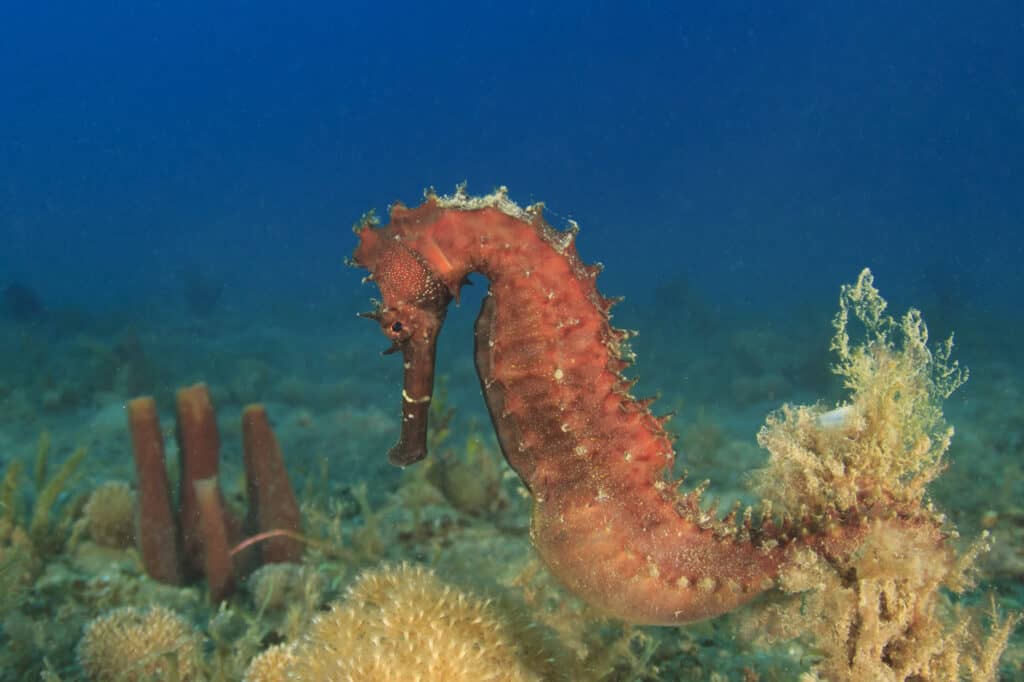
The male
seahorse
carries the young in a pouch.
©Rich Carey/Shutterstock.com
The Largest Fish That Starts With S
If we don’t count the shark species (including the largest fish, the whale shark), then the largest fish truly beginning with S is a Southern sunfish, and it’s a whopper.
Southern sunfish, or Ramsay’s sunfish, can weigh 2.3 tons and reach 11 feet long. This considerable fish lives in the Southern Hemisphere’s oceans and uses its large fins to swim horizontally through the water.
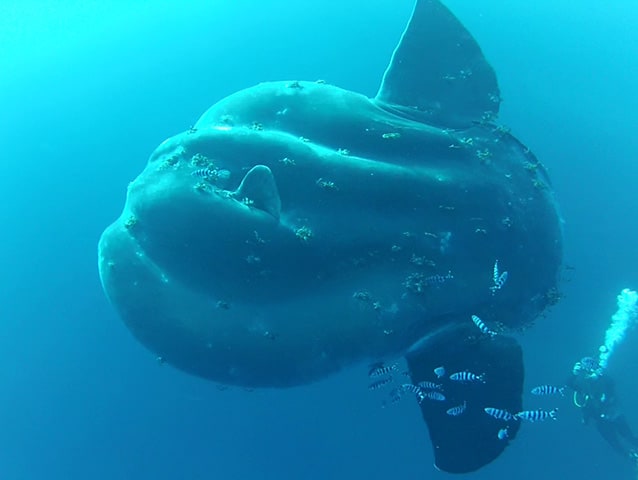
The largest fish truly beginning with S is a Southern sunfish.
©Photo by Erik van der Goot, used with permission, provided to FishBase by Marianne Nyegaard / CC BY-SA 4.0 – License
Summary of 81 Fish That Start With S in Alphabetical Order
If you want to discover more fish that start with S, here’s a table listing 81 fish species.
| Fish that start with S: Common name | Scientific name |
|---|---|
| Sabertooth | Coccorella atrata |
| Sablefish | Anoplopoma fimbria |
| Sacramento blackfish | Orthodon microlepidotus |
| Sacremento splittail | Pogonichthys macrolepidotus |
| Saddle cichlis | Aequidens tetramerus |
| Saddleback hill-stream loach | Gastromyzon punctulatus |
| Saddled hillstream loach | Homaloptera orthogoniata |
| Sailfin characin | Crenuchus spilurus |
| Sailfin pleco | Pterygoplichthys gibbiceps |
| Sailfin pleco | Pterygoplichthys gibbiceps |
| Sailfin silverside | Marosatherina ladigesi |
| Sailfish | Istiophorus albicans |
| Sajica cichlid | Cichlasoma sajica |
| Sajica cichlid | Cichlasoma sajica |
| Salmon | Salmo salar |
| Sand tiger shark | Carcharias taurus |
| Sand dab | Citharichthys sordidus |
| Sand diver | Trichonotus filamentosus |
| Sand goby | Pomatoschistus minutus |
| Sandbar shark | Carcharhinus plumbeus |
| Sawfish | Pristis pritis |
| Sculpin | Myoxocephalus octodecemspinosus |
| Sea bream | Diplodus vulgaris |
| Sea catfish | Bagre marinus |
| Sea chubb | Girella fimbriata |
| Sea angler | Ceratias holboelli |
| Sea dragon | Phyllopteryx taeniolatus |
| Sea lamprey | Petromyzon marinus |
| Sea toad | Chaunacops cf. melanostomu |
| Seahorse | Hippocampus sp. |
| Serrated piranha | Serrasalmus serrulatus |
| Seven spotted archerfish | Toxotes chatareus |
| Shad | Alosa fallax |
| Shark | cl. Chondrichthyes |
| Short-finned Congo tetra | Hemigrammopetersius intermedius |
| Short-Lined pyrrhulina | Pyrrhulina brevis brevis |
| Shortnose gar | Lepisosteus platostomus |
| Shortnose sturgeon | Acipenser brevirostrum |
| Shortnose sucker | Chasmistes brevirostris |
| Shovelnose catfish | Sorubim lima |
| Siamese fighting fish | Betta splendens |
| Siamese flying xox | Crossocheilus siamensis |
| Silver distichodus | Distichodus affinis |
| Silver hatchetfish | Gasteropelecus sternicla |
| Silver pacu | Colossoma brachypomum |
| Silver shark | Balantiocheilus melanopterus |
| Silverside | Melanotaenia boesemani |
| Silvertip tetra | Hasemania nana |
| Sind danio | Devario devario |
| Six barred epiplatys | Epiplatys sexfaciatus |
| Slender mbuna | Pseudotropheus elongatus |
| Slender tail hap | Buccochromis lepturus |
| Smooth dogfish | Mustelus canis |
| Snake eel | Myrichthys ocellatus |
| Snake mackerel | Gempylus serpens |
| Snakeskin gourami | Trichogaster pectoralis |
| Snapper | Lutjanus sp. |
| Snipefish | Macroramphosus gracilis |
| Snook | Centropomus undecimalis |
| Socolof’s mbuna | Pseudotropheus socolofi |
| Socolof’s tetra | Gymnocorymbus socolofi |
| Soldierfish | Myripristis jacobus |
| South America darter | Cahacidium fasciatum |
| Southern smelt | Retropinna retropinna |
| Southern soft-spined rainbowfish | Rhadinocentrus ornatus |
| Southern Soft-Spined Rainbowfish | Rhadinocentrus ornatus |
| Spadefish | Platax teira |
| Sparkling earth eater | Satanoperca acuticeps |
| Sparkling panchax | Apolocheilis lineatus |
| Speciosus cichlid | Lamprologus speciosus |
| Spikefish | Parahollardia lineata |
| Spilotum | Cichlasoma nicaraguense |
| Spiny dwarf catfish | Scoloplax dicra |
| Spiny eel | Macrognathus aculeatus |
| Spiny fin | Diretmus argenteus |
| Spot-line peacock cichlid | Cichla temensis |
| Squaretail | Tetragonurus cuvieri |
| Stingray | Myliobatiformes order. |
| Stonefish | Synanceia verricosa |
| Swordfish | Xiphas gladius |
The photo featured at the top of this post is ©
Thank you for reading! Have some feedback for us? Contact the AZ Animals editorial team.



